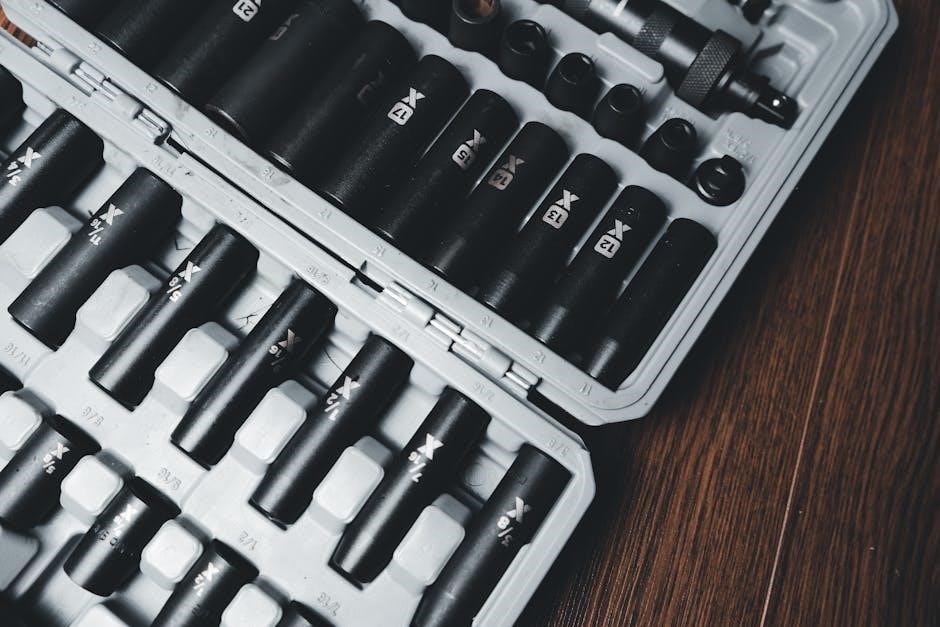
The Snap-on Torque Wrench Manual is an essential guide for professionals and DIYers, providing detailed instructions for safe and effective use of mechanical and electronic torque wrenches.
It covers key features, calibration, and maintenance tips to ensure accuracy and longevity, making it a critical resource for maximizing tool performance in various applications.
Overview of the Snap-on Torque Wrench Manual
The Snap-on Torque Wrench Manual is a comprehensive guide designed to help users understand and utilize their tool effectively. It covers essential topics such as safety precautions, proper tool setup, and maintenance routines. The manual also provides detailed instructions for operating both mechanical and electronic models, ensuring accuracy and precision. Intended for both novice and experienced users, it offers clear, step-by-step directions to maximize the tool’s performance and longevity. This resource is indispensable for anyone aiming to master the use of Snap-on torque wrenches.
Importance of Reading the Manual
Reading the Snap-on Torque Wrench Manual is crucial for ensuring safe and effective use of the tool. It provides essential insights into proper operation, safety guidelines, and maintenance tips. By understanding the manual, users can avoid errors, prevent damage to equipment, and ensure accurate torque settings. It also helps users familiarize themselves with advanced features and troubleshooting methods. Whether you’re a novice or an experienced professional, the manual is a vital resource for maximizing tool performance and longevity.

Understanding the Snap-on Torque Wrench
Snap-on torque wrenches are precision-engineered tools designed for accuracy and versatility. They offer adjustable torque control, ergonomic designs, and durability, making them ideal for various industrial applications.
Mechanical vs. Electronic Torque Wrenches
Mechanical torque wrenches rely on internal mechanisms to measure torque, offering simplicity and reliability. They are often preferred for straightforward applications due to their durability and ease of use. Electronic torque wrenches, on the other hand, use digital technology for precise measurements and advanced features like data logging and angle measurement. They are ideal for complex tasks requiring high accuracy and real-time feedback. Both types cater to different needs, ensuring versatility across various industries;
Key Features of Snap-on Torque Wrenches
Snap-on torque wrenches are renowned for their precision, durability, and advanced functionality. They feature high-resolution digital displays for accurate torque measurements, preset alerts for target torque levels, and the ability to measure both torque and angular rotation. Many models offer data logging capabilities, storing torque values for later review. Their ergonomic design ensures comfort during extended use, while robust materials withstand demanding environments. These tools are built to deliver consistent performance, making them indispensable for professionals requiring reliability and accuracy in critical applications.
Available Models: TQ-Series, QE-Series, and TECHANGLE
The Snap-on torque wrench lineup includes the TQ-Series, known for its high torque capacity and durable construction, making it ideal for heavy-duty applications. The QE-Series offers a compact design with precise control, suitable for diverse environments. The TECHANGLE model combines torque and angle measurement, ensuring accuracy for complex tasks. Each series is tailored to specific user needs, providing versatility and reliability across industries. These models are designed to deliver superior performance, catering to professionals who demand precision and durability in their tools.

Safety Guidelines
Always wear safety gear, use the tool correctly, and avoid misuse. Follow all guidelines in the manual to ensure safe and effective operation.
General Safety Precautions
Always wear safety glasses and ensure the work area is clear of hazards. Avoid over-torquing, as it can damage components or cause injury. Keep loose clothing and long hair tied back. Ensure proper grip and stance to maintain control. Never use a torque wrench near open flames or sparks. Avoid exposing the tool to extreme temperatures or moisture. Regularly inspect the wrench for damage. Use only Snap-on-approved accessories to prevent malfunctions. Follow all guidelines in the manual to ensure safe and precise operation. Proper safety practices protect both the user and the equipment.
Proper Handling and Storage
Always handle the torque wrench with care to prevent damage. Store it in a protective case or pouch when not in use. Keep the tool in a dry, clean environment away from extreme temperatures. Avoid exposing it to direct sunlight or moisture. Regularly clean the wrench with a soft cloth to remove dirt or grease. Ensure the wrench is properly calibrated before storage. Never store it in a compressed or bent position, as this can alter its accuracy. Proper handling and storage extend the tool’s lifespan and maintain its precision. Regular inspections before storage are essential for long-term reliability.
Warning Symbols and Their Meanings
The manual includes warning symbols to alert users of potential hazards. A triangle with an exclamation mark indicates general warnings. A hand symbol signifies wearing gloves. A skull or crossbones denotes dangerous materials. A lightning bolt warns of electrical hazards. A torque wrench symbol with a line through it means improper use is prohibited. Understanding these symbols ensures safe operation and prevents accidents. Always refer to the manual for detailed explanations of each symbol and its implications for tool usage and safety protocols.

Setting Up the Torque Wrench
Unpacking and inspecting the tool are initial steps. Initial activation and mode selection follow. Understanding display modes ensures proper setup. This ensures the wrench is ready for precise and safe use.
Unpacking and Inspecting the Tool
Begin by carefully unpacking the Snap-on torque wrench from its packaging; Inspect for any visible damage or wear. Verify all components, such as the wrench, manual, and accessories, are included. Check the tool for proper lubrication and ensure no parts are loose. Examine the torque wrench for any signs of tampering or defects. Refer to the manual for specific inspection guidelines. This step ensures the tool is in optimal condition before first use, preventing potential operational issues.
Initial Activation and Mode Selection
Power on the Snap-on torque wrench by pressing the power button. Allow the tool to complete its self-test. Navigate to the setup menu using the control buttons. Select the desired torque unit (e.g., ft-lb or Nm). Choose the operating mode, such as torque, angle, or a combination, based on your task. Refer to the manual for mode-specific instructions. Ensure the tool is set to the correct mode before use to achieve accurate results and maintain tool reliability.
Understanding Display Modes
The Snap-on torque wrench features multiple display modes to suit different tasks. The Torque Mode shows real-time torque values, while the Angle Mode displays angular rotation. The Combined Mode offers both torque and angle data simultaneously. Use the arrow keys to cycle through modes. The display also indicates the selected unit of measurement and battery level. Familiarize yourself with these modes to optimize tool functionality and ensure precise results during operations. Refer to the manual for detailed explanations of each mode’s application.
Calibration and Maintenance
Regular calibration ensures accuracy, while proper cleaning and storage prevent damage. Use authorized service centers for repairs. Schedule maintenance to maintain optimal tool performance and longevity.
Why Calibration is Important
Calibration ensures the torque wrench delivers accurate readings, essential for precise fastening. Inaccuracies can lead to under- or over-tightening, causing equipment failure. Regular calibration maintains reliability, prevents safety hazards, and ensures compliance with manufacturer specifications. Improper calibration voids warranties and compromises tool performance. Snap-on recommends calibration every 12 months or after 5,000 cycles to uphold precision and longevity. Always use authorized service centers for professional recalibration to maintain optimal functionality and trust in your torque wrench measurements.
Cleaning and Storage Tips
Regular cleaning and proper storage are crucial for maintaining the performance and longevity of your Snap-on torque wrench. Use a soft, dry cloth to wipe down the tool, removing dirt and grime. Avoid harsh chemicals or abrasive materials that may damage the finish. Store the wrench in its protective case, away from direct sunlight and moisture. Ensure the storage area is cool and dry to prevent rust or corrosion. Always re-calibrate the wrench after extended storage to ensure accuracy. Proper care extends the tool’s lifespan and reliability.
Authorized Service Centers for Repairs
For any repairs, use only Snap-on authorized service centers to ensure compliance with quality and safety standards. These centers employ factory-trained technicians and use genuine parts to maintain your torque wrench’s performance. Visit the official Snap-on website or contact customer support to locate the nearest authorized service center. Avoid unauthorized repairs, as they may void the warranty and compromise accuracy. Proper servicing ensures optimal functionality and extends the tool’s lifespan. Always verify the center’s authorization before proceeding with any repairs.

Operating the Torque Wrench
Always set the desired torque value and use the proper grip and stance for precise control, ensuring accurate torque application and minimizing operator fatigue.
Setting the Desired Torque Value
To set the desired torque value on your Snap-on torque wrench, refer to the manual for specific instructions. Adjust the torque scale to match your required specification using the adjustment knob. For electronic models, use the digital interface to input the precise value. Ensure the wrench is set to the correct unit of measurement (e;g., ft-lb or Nm). Double-check the setting against a torque chart or the manufacturer’s guidelines to confirm accuracy. Always verify the setting before applying torque to avoid damage or injury.
Proper Grip and Technique
Ensure a firm, consistent grip on the torque wrench handle to maintain control. Avoid over-tightening by using only the handle, not additional tools like pipe wrenches. Stand with proper body positioning, applying force directly without straining. For precise torque application, keep the wrench at a 90-degree angle to the bolt or nut. Maintain steady movement to prevent slippage. Refer to the manual for model-specific diagrams illustrating optimal grip and technique for both mechanical and electronic models. Proper technique ensures accuracy and safety.
Monitoring Torque and Angular Rotation
Monitor torque and angular rotation closely during operation to ensure precise results. For digital models, the display shows real-time torque values and angular measurements. Pay attention to the preset target and audible/visual alerts when torque is reached. For mechanical models, rely on the slip mechanism to indicate torque achievement. Track angular rotation for bolts requiring angle-based tightening. Ensure readings align with specifications to avoid over-torqueing. Refer to the manual for model-specific monitoring instructions and accuracy tips.

Troubleshooting Common Issues
This section helps address common problems like accuracy errors, display malfunctions, and mechanical failures. It provides step-by-step solutions and tips to resolve issues quickly and effectively.
Resolving Accuracy Problems
Accuracy issues with Snap-on torque wrenches often stem from calibration errors or improper setup. To resolve these, recalibrate the tool following the manual’s instructions or reset it to factory settings. Ensure the wrench is properly zeroed and free from physical damage. If problems persist, restart the device or consult the troubleshooting guide. Always refer to the manual for specific recalibration procedures to maintain precision and reliability. Regular maintenance and proper handling can prevent such issues from arising. Accuracy is crucial for safe and effective operation.
Addressing Display Malfunctions
If the display on your Snap-on torque wrench malfunctions, start by restarting the device. Ensure the battery is fully charged or replace it if necessary. Check for any obstructions or damage to the LCD screen. If issues persist, reset the wrench to factory settings or update its software. For severe malfunctions, contact Snap-on customer support or visit an authorized service center. Regularly cleaning the screen and avoiding extreme temperatures can prevent such problems. Always refer to the manual for specific troubleshooting steps.
Handling Mechanical Failures
If mechanical components of your Snap-on torque wrench fail, inspect for wear or damage. Check the drive mechanism, gears, and adjustment systems. Ensure all parts are securely tightened and properly aligned. Lubricate moving parts if specified in the manual. For severe damage, discontinue use and contact an authorized service center. Regular maintenance can prevent most mechanical issues. Never attempt repairs without proper tools and expertise, as this may void the warranty or compromise tool accuracy. Always follow the manual’s guidance for inspections and maintenance.

Manual Structure and Content
The Snap-on Torque Wrench Manual is organized into clear sections, covering setup, operation, maintenance, and troubleshooting. It includes detailed safety tips and technical specifications for optimal use.
Sections of the Manual Explained
The Snap-on Torque Wrench Manual is divided into distinct sections for easy navigation. It begins with an introduction, followed by understanding the tool, safety guidelines, setup, calibration, operation, troubleshooting, and maintenance. Each section provides detailed instructions, ensuring users can master the torque wrench’s features and resolve issues efficiently. The manual also includes quick reference guides and additional resources for advanced applications, making it a comprehensive guide for both beginners and experienced professionals.
Using the Manual for Advanced Applications
The manual provides detailed guidance for advanced users, offering insights into custom torque settings, specialized modes, and precision calibration. It explains how to utilize the torque wrench for complex tasks, such as multi-step bolting or angular tightening. Advanced users can explore features like data logging, torque curves, and integration with other tools. The manual ensures professionals can unlock the full potential of their Snap-on torque wrench, enabling precise and efficient results in demanding applications.
Quick Reference Guides
The manual includes quick reference guides to help users rapidly access essential information. These guides provide streamlined instructions for common tasks, such as setting torque values, switching between modes, and interpreting alerts. Designed for efficiency, they minimize time spent on complex operations. Visual diagrams and charts are often included to simplify understanding. These guides are ideal for both new and experienced users, ensuring quick troubleshooting and operation without delving into the full manual. They enhance productivity and reduce errors in high-pressure environments.

Key Takeaways
Key takeaways emphasize proper technique, regular calibration, and storage to ensure accuracy and longevity. Following these guidelines maximizes tool performance and user safety.
Best Practices for Tool Longevity
To ensure your Snap-on torque wrench lasts, store it in a dry, cool place, and avoid extreme temperatures. Regularly clean the tool to prevent dirt buildup. Always use the correct socket size and avoid overloading, which can damage internal mechanisms. Calibrate the wrench annually or as specified to maintain accuracy. Follow the manual’s guidelines for proper handling and maintenance to prevent wear and tear. Proper care and adherence to these practices will extend the tool’s lifespan and performance.
Maximizing Precision and Accuracy
To maintain precision, always calibrate your Snap-on torque wrench according to the manual’s instructions. Use the correct torque values for your specific application to avoid over-tightening or under-tightening. Ensure the tool is free from dirt and debris, as contamination can affect accuracy. Regularly check for software updates if using a digital model. Following these steps ensures consistent and reliable results, making your Snap-on torque wrench a trusted tool for precise operations.
Importance of Regular Servicing
Importance of Regular Servicing
Regular servicing ensures your Snap-on torque wrench performs optimally and maintains accuracy over time. Wear and tear can affect its precision, so scheduling periodic checks with authorized service centers is crucial. Servicing helps identify and repair potential issues before they escalate, ensuring reliability and safety. Adhering to the recommended servicing schedule guarantees peak performance and extends the tool’s lifespan, making it a worthwhile investment for professionals and enthusiasts alike.

Additional Resources
Access the official Snap-on torque wrench manual PDF online for detailed guides. Visit the Snap-on website for support, FAQs, and downloadable resources to enhance your tool experience.
Online Support and Downloads
The official Snap-on website offers comprehensive online support, including downloadable PDF manuals for torque wrenches. Users can access product-specific guides, troubleshooting tips, and instructional videos. The site features a dedicated support section where you can search for the Snap-on torque wrench manual PDF by model number or product name. Additionally, registered users can log in to access exclusive content, ensuring they stay updated with the latest tools and technologies for optimal performance and maintenance.
Customer Service Contact Information
For assistance with your Snap-on torque wrench, contact customer service at 1-877-SNAP-ON-1 (1-877-762-7661) or visit www.snapon.com. Support is available for questions about the manual, torque settings, or troubleshooting. The website also provides access to the Snap-on torque wrench manual PDF, FAQs, and additional resources. Representatives are ready to help with product inquiries, repairs, or technical support, ensuring optimal performance and resolving any issues promptly and efficiently.
Recommended Accessories
To enhance your Snap-on torque wrench experience, consider these recommended accessories. A high-quality socket set ensures compatibility with various bolt sizes. An extension bar provides extra reach for difficult applications. A torque multiplier is ideal for high-torque requirements. Additionally, a storage case protects your tool, and a calibration certificate ensures accuracy. Visit the Snap-on website or consult the manual for a full list of compatible accessories designed to maximize efficiency and precision with your torque wrench.
The Snap-on torque wrench manual emphasizes proper usage, safety, and maintenance for optimal performance. By following guidelines, users ensure accuracy and longevity. Stay updated for future improvements.
Final Thoughts on Using the Manual
The Snap-on torque wrench manual is a comprehensive guide designed to enhance understanding and proper use of the tool. By adhering to its instructions, users can ensure precision, safety, and longevity of their torque wrench. The manual also serves as a troubleshooting resource and maintenance guide, helping users address common issues and optimize performance. Always refer to the manual for specific models and updates, and reach out to support for additional assistance. Proper usage, as outlined, guarantees professional results.
Future Updates and Improvements
Snap-on regularly updates its torque wrench manual to reflect advancements in technology and user feedback. Future updates may include enhanced digital features, improved compatibility with smart tools, and expanded troubleshooting guides. Users can expect better navigation, real-time updates, and integration with other diagnostic tools. Staying informed through Snap-on’s official channels ensures access to the latest resources and optimal tool performance.

Emerging Trends in Torque Wrench Technology
Snap-on torque wrench technology evolves with digital innovation, offering real-time data and smart tool integration. These advancements enhance accuracy, user experience, and efficiency in precise applications.
Advancements in Digital Torque Wrenches
Digital torque wrenches now feature high-precision sensors, ensuring superior accuracy and repeatability. Modern designs include touchscreens, data logging, and connectivity options like Bluetooth or Wi-Fi for real-time monitoring. Users can set torque limits, track angular rotation, and store data for analysis. Integration with software enhances documentation and reporting, making these tools indispensable for industrial and automotive applications. These advancements simplify complex tasks, improve efficiency, and reduce human error, setting new standards in precision engineering and maintenance workflows.
Integration with Smart Technology
Modern Snap-on torque wrenches integrate seamlessly with smart technology, enhancing functionality. Bluetooth and Wi-Fi connectivity enable real-time data transfer to mobile devices or computers. This allows for precise torque monitoring, data logging, and sharing of results. Smart technology also supports software updates, ensuring tools stay current with the latest features. Integration with IoT platforms enables remote monitoring and predictive maintenance, streamlining workflows. This connectivity enhances accuracy, reduces errors, and simplifies documentation, making it ideal for advanced industrial and automotive applications.